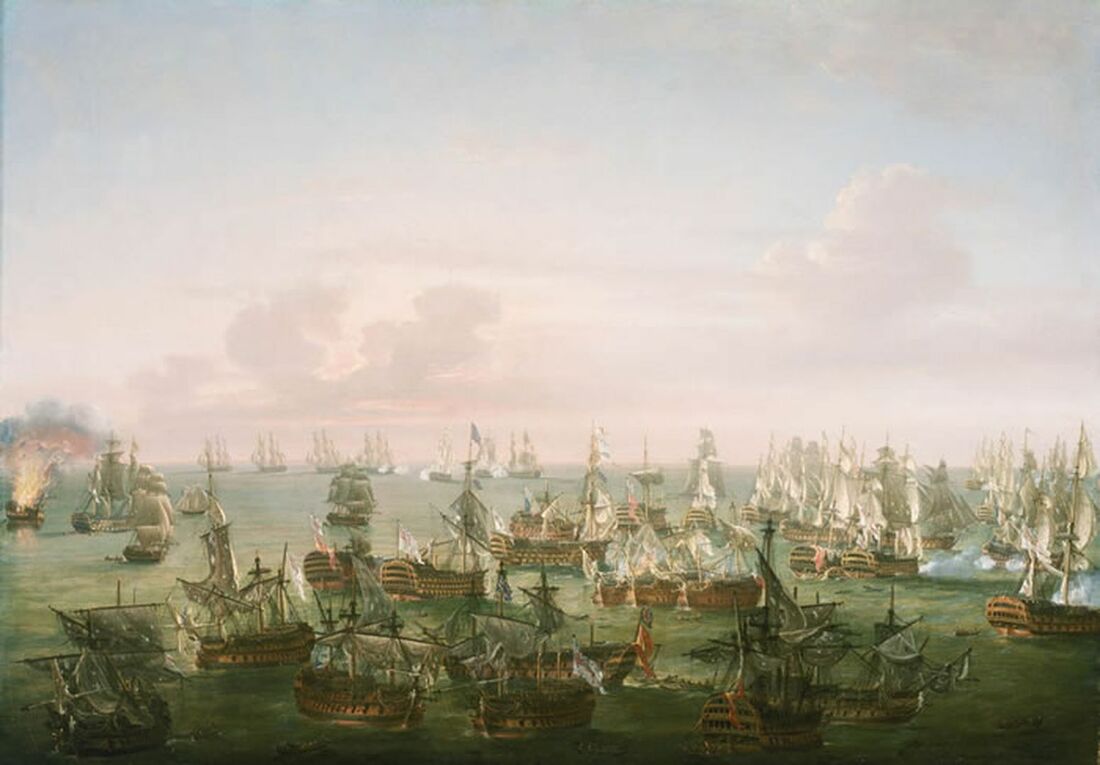Auction: 24001 - Orders, Decorations and Medals
Lot: 141
The fascinating Royal National Institution for the Preservation of Life from Shipwreck medal in Gold awarded to Lieutenant J. Lindsay, Royal Navy, whose life afloat included many instances of active and important service - not least at the Battle of Trafalgar, where he was wounded as Acting 2nd Master of H.M.S. Mars, a vessel in the thick of the action on that famous day
Royal National Institution for the Preservation of Life From Shipwreck, gold, 40.87g., Type I, 1824-1862, King George IV obverse (Lieut. James Lindsay R.N. 7 Feby 1827), with integral gold band, eyelet suspension ring and riband ring and gold riband buckle, upper part of applied rim re-affixed, good very fine
Provenance:
Sotheby, 1971.
Spink, April 2007.
R.N.I.P.LS. Medal in Gold, voted 7 February 1827, states:
'The Inverness sloop Lively went on shore during severe weather near Fort George, Nairn, with the Master, two seamen and one female passenger on board. Using Lively's boat, which had been driven ashore, Lieutenant Lindsay and his two men went alongside. Soon the boat was swamped and went to pieces, and they were forced to board the sloop where they remained for two hours. With the sea running over the vessel, Lieutenant Lindsay had continually to hold the female passenger to prevent her from being swept overside. The bottom of the sloop was out by this time and, half an hour after they were finally taken off by the Coastguard boat, she broke up.'
James Lindsay, a native of Aberdeen, was born in 1783 and joined the Royal Navy on 22 August 1803 at the comparatively advanced age of 20. Initially rated Able Seaman aboard the 18-gun H.M.S. Snake, the following year he was appointed Midshipman on H.M.S. Vertu, a recently-captured French frigate, although he did not remain with her long before removing to the 74-gun H.M.S. Mars, commanded by Captain George Duff. This ship had the distinction to play a very active role in the Trafalgar Campaign: Duff commanded the inshore squadron monitoring Cadiz and was responsible for informing Admiral Lord Nelson of the escape of the Franco-Spanish fleet.
At the Battle of Trafalgar on 21 October 1805, Mars was third in Admiral Collingwood's Lee Division, and as such in the thick of the action - indeed, over the course of the battle she was attacked by no less than five different French and Spanish ships and lost 29 men killed and 69 wounded. One of the former was, unfortunately, Captain Duff who, early on in the action, was decapitated by a French roundshot. Sadly, Duff's thirteen-year-old son was a member of the midshipman's berth (and must therefore have been a known shipmate to Lindsay) and one can only imagine his distress at the death of his father. By this time Lindsay had been appointed Acting 2nd Master, likely responsible for assisting the Master (Mr. Thomas Cook) in sailing Mars, and therefore just as likely to have been in an exposed position on the quarterdeck - no wonder he is noted as having been wounded (as indeed was Mr. Cook), and may well have been a personal witness to Duff's tragic demise.
Remaining aboard Mars for several years after that momentous day, in July 1806 he participated in the 26-hour chase (and eventual capture) of the French 40-gun frigate Rhin, and in September the same year was under fire again in the 'Action of 25 September 1806', where Commodore Sir Samuel Hood's squadron captured four French frigates - Mars specifically taking the Infatigable after a short fight. Next sent to the Baltic and involved in the expedition and bombardment of Copenhagen in 1807, Lindsay was next appointed to the 98-gun H.M.S. Barfleur in home waters. In January 1812 he was made Acting-Sub-Lieutenant of the 4-gun schooner H.M.S. Herring on the North America station, before a further transfer to the 12-gun H.M.S. Musqhedchet in July 1813. Coming back to Europe in 1814, he was finally - and deservedly - promoted Lieutenant on 13 February 1815.
Later Life and a Gallant Act Rewarded
In the post-war reduction of the Royal Navy, like many junior officers Lindsay accepted a position with the Coastguard service and 1827 found him back in his native Scotland and in command of the station at Fort George, Inverness. During a great storm on 2 January 1827, he and two of his men went to the rescue of the crew and passenger of a wrecked sloop, and after many hours' exertion on their behalf saved all their lives without loss. In addition to the official citation, the original recommendation survives, as witnessed by four army officers on shore, who stated:
Fort George, January 2nd 1827
We, the undersigned, do certify that Lieut. James Lindsay R.N., of the Coastguard, stationed at Fort George, accomapnied by two of his men, William Cork and Alexander Gray, boatmen, who volunteered to accompany Lieut. Lindsay on 2nd January 1827, did at imminent risk to their lives, and through a tremendous sea, succeed in saving the crew (three in number) and one female passenger, belonging to the sloop Lively, of Inverness, then a wreck on the back of Fort George.
We further state as a fact well known to all those who witnessed this disturbing scene, that had it not been for the active exertions of these gallant men, the above mentioned four persons must, in all human probability, have lost their lives, as the boat belonging to the wreck had been previously swamped and the vessel went to pieces a few minutes after the crew were taken from her.'
James Mill, Major Comm. Depot, 78th Highlanders.
Andrew Fraser, Fort Major, Fort George.
Hammond A. Tapp, Captain, Royal Engineers.
Harry Bisshopp, Lieut., Royal Regiment of Artillery.
In addition to Lindsay's Gold medal, Cork and Gray were awarded Silver medals, and the gallant Lieutenant shortly afterward went on to command the Revenue cutter Stork from 1829 - 1829. Lindsay died in 1845 and, therefore, sadly did not qualify for what would have been an especially well-deserved Naval General Service Medal.
Sold together with a small file of copied research and a hand-written copy of the witness statement, this latter upon R.N.L.I. headed notepaper addressed from '14 John Street, Adelphi, London, W.C.', noted 'Copy' but certainly of some age.
Subject to 20% VAT on Buyer’s Premium. For more information please view Terms and Conditions for Buyers.
Sold for
£6,500
Starting price
£3500







